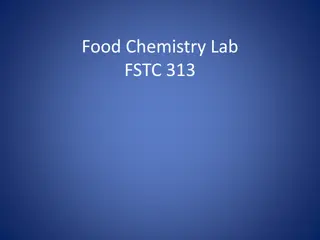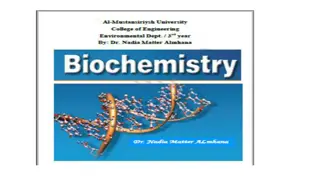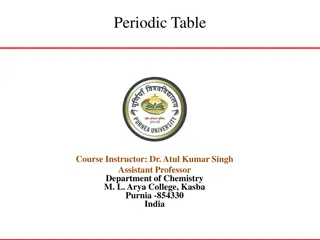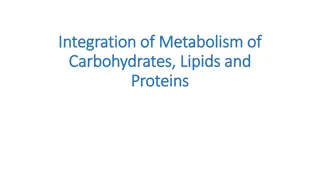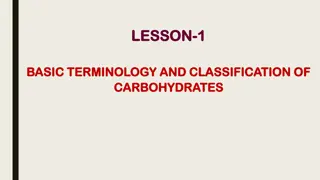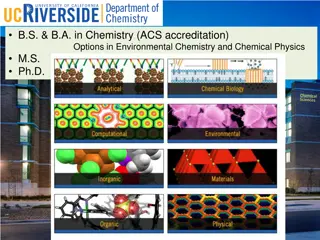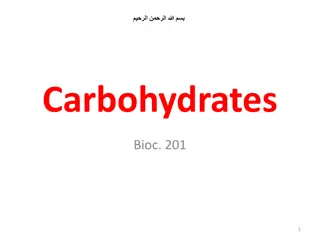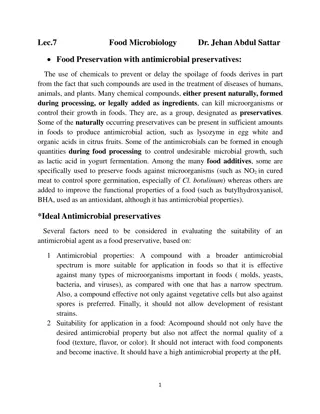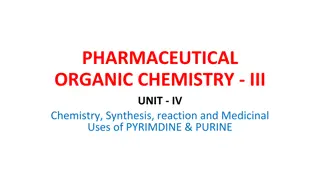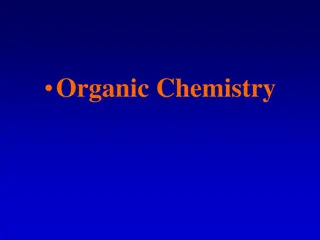Properties and Utilization of Common Polysaccharides in Food Chemistry
Polysaccharides are carbohydrates with more than 10 monosaccharide units, commonly found in foods like starch, cellulose, glycogen, hemicellulose, and pectic substances. Starch, a natural polymer of D-glucose, is a major energy source in the human diet, present in cereals, roots, and tubers. It consists of two main polymers, amylose and amylopectin, each with distinct properties and functions. Sources of starch include cereals, millets, and starchy food crops. Understanding the structure and properties of these polysaccharides is essential for their effective utilization in food applications.
Download Presentation

Please find below an Image/Link to download the presentation.
The content on the website is provided AS IS for your information and personal use only. It may not be sold, licensed, or shared on other websites without obtaining consent from the author. Download presentation by click this link. If you encounter any issues during the download, it is possible that the publisher has removed the file from their server.
E N D
Presentation Transcript
FOOD CHEMISTRY DTC-321 Credit hours-3(2+1) Properties and Utilization of Common Polysaccharides BINITA RANI ASSOCIATE PROFESSOR (DAIRY CHEMISTRY) FACULTY OF DAIRY TECHNOLOGY S.G.I.D.T., BVC CAMPUS, P.O.- BVC, DIST.-PATNA-800014
Polysaccharides -- carbohydrates > 10 monosaccharide units. Hydrolyzed -- hundred or even thousands of monosaccharide units. Commonly present in foods : starch, cellulose, glycogen, hemicellulose, pectic substances.
STARCH widely in vegetables kingdom. > 80 % of all food crops -- cereals and starchy food crops Natural polymer of D-glucose. a very high proportion of world s food energy intake. Occurs in nature as microscopically small, spherical particles / granules -- whose size and shape are characteristic each species. Formed in plants condensation of large no. of glucose molecules -- into two types of polymers : 1. Amylose -- linear polymer > 2000 glucose units -- -1,4 glycosidic linkage. 2. Amylopectin -- highly branched -- each branch -- 20 - 30 glucose units & each molecule hundreds of these branches. Glucose units in linear branch -- -1,4 linkage. Branch points -- -1,6-glycosidic linkages. Both amylose and amylopectin deposited in starch granules an orderly radial pattern.
Sources of starch : (i)Cereals and millets (65 to 85 %) e.g., rice, wheat, maize (ii)Roots and tubers (19 to 35 %) e.g. tapioca, potato Cereal starch paste (5%) on cooling sets a thick jelly Turber starch paste (5%) a fluid & does not set to a thick jelly. Cereals low moisture proteinaceous matrix requires preliminary softening starch extraction. Potato high moisture and no preliminary softening required. starch granules are embedded in a hard,
Amylose Long unbranched chain of D-glucose (500 to 5,000 glucose molecules) -- linked -- -1,4 linkage Molecular weight -- 105 to 106 daltons . Retrogradation -- process -- solution (on keeping) turns turbid -- due to precipitations of amylose. Responsible -- stiffening of cooked rice (on standing). Blue colour with iodine. Amylose content of starch -- vary botanical species. Cereal starches : wheat starch 25 30% amylose, corn starch (amylomaize) 40 80% amylose. Waxy maize 0% starch.
Amylopectin Branched chain polysaccharide component of starch Chains linked -1,6 linkages Molecular weight 107 to 108 daltons One molecule 50,000 to 5,00,000 molecules of D-glucose Gives purple colour with iodine
Gelatinization of starch process breaks down the intermolecular bonds of starch molecules (in the presence of water and heat) allowing hydrogen bonding sites to engage more water. This irreversibly dissolves the starch granule. Penetration of water randomness in general granule structure and no. and size of crystalline regions (do not allow water entry). Heat causes such regions to become diffuse chains begin to separate into an amorphous form. Gelatinization influenced by a number of factors: plant type (wheat and corn starch show different behaviour patterns), size of starch granule, amount of water present, pH, gelatinization temperature and the length of heating Some type of unmodified native starches start swelling at 55 C, other types at 85 C
Retrogradation of starch Starch molecules (in dilute solutions) precipitate -- insoluble material being difficult to redissolve by heating. Process of dissolved starch -- becoming less soluble -- called retrogradation. Retrogradation of cooked starch amylose and amylopectin. Amylose undergo retrogradation at a much more rapid rate than does amylopectin. Rate of retrogradation depends on : botanical source of starch, molecular ratio of amylose to amylopectin, starch concentration, temperature, salts and surfactants. Bread staling due to starch retrogradation due to the gradual transition of amorphous starch to a partially crystalline, retrograded state.
Modified Starches: Behaviour of pastes of common native starches often unsatisfactory used in modern food industry . Modified starches and starch derivatives with more sophisticated stability characteristics have been developed. Modified starches include : (i)Acid modified starches (ii)Pre-gelatinized starches (iii)Cross-linked starches (iv)Esters & ethers of starch (v)Starch phosphates (vi)Hydroxy alkyl substituted starch
Acid modified starch Heat Starch granules & dil. HCl acid ---------------------------- Acid modified starch. Swell less during gelatinization reduced volume and lower maximum hot paste viscosity. Solubility in hot water increased (extent degree of acid treatment). temp < gelatinization Use fruit gums strength and clarity of the resultant gel improved. Viscosity of gel reduced hot gel easily poured into moulds. Gel strength increased (because of degradation of amylopectin). Gel clarity improved.
Pre-gelatinized starches prepared viscosity. Cooked paste dried on rollers or spray-drier. Powdered product easily rehydrate in cold water but, Resultant dispersions not equivalent to freshly prepared paste (due to starch degradation ). destroying the granular structure on cooking considerable reduction in paste Uses water holding or thickening agent many food. 1.Instant puddings a packaged powder mixed with cold milk stand for few minutes simple pudding. (Powders mixture of pre-gelatinized starch , sugar , flavourings, salts produce viscosity increase in the milk to keep the starch suspended until hydration can take place). 2.Frozen fruit-pie fillings pre-gelatinized starch keeps the fruit suspended and helps retain the flavour.
Cross-linked and other derivatized starches A great number of esters and ethers of starch infinite range of physicochemical properties (heat stability) can be prepared. Only a few of these are important in the food industry. Starch phosphates(analogues in the amylopectin fraction of root and tuber starches) starch derivatives suitable as food additives. Introduction of free-acid groups starch phosphates both increases and stabilizes the paste viscosity by : Negatively charged phosphate groups expand the molecule in solution Coulombic repulsion Prevent the formation of aggregates
high viscosity and paste clarity starch phosphates extensive use as thickners and texturizing agents. resistance to molecular aggregation formulation of frozen foods. Swelling and ultimate breakdown of starch granules during cooking can be controlled by introducing a suitable number of cross-linkages between the molecules by esterification with trimetaphosphate. Starch with low level of phosphate cross linking used in textural modification of food e.g., Cross bonded phosphate starches are used as thickners in salad cream and fruit-pie fillings. Introduction of hydroxyalkyl substituent increases the solubility of starch and prevents molecular aggregation e.g. hydroxypropyl starch. Hydroxyalkyl starches gelatinize at lower temperature than the parent starch and paste show little tendency to form gels. .
Cellulose Most abundant polysaccharide main structural material. linear polymer of D-glucose units linked (1 4) in the configuration unbranched contain as many as 5,000 glucose units. Because of - linkage glucose units alternate in the chain molecule is effectively rigid and straight chain. cellulose molecules readily align themselves side-by-side in an arrangement which is stabilized by intermolecular hydrogen bonding and form crystalline regions insoluble in water. cellulose is responsible form and gross texture foodstuffs. Being insoluble little affected by cooking process and does not disperse. On ingestion unaffected by enzymes in the digestive tract & does not hydrate.
Glycogen reserve polysaccharide in the animal body. muscles (0.5 to 1 percent) and liver (3 to 7 percent). resembles starch chemical properties. formed by condensation large number (5,000-10,000) of glucose molecules. branched chain polysaccharide resembling amylopectin. chain length 8 to 12 glucose units. molecular weight of glycogen 105 to 108 daltons.
Hemicellulose present in plant tissues. structural components of the cell wall. water insoluble, non-starchy polysaccharides. heteropolysaccharides. Monosaccharide units xylose, arabinose, galactose, glucose, glucuronic acid. nonfibrous while celluloses are fibrous. more soluble in alkali and more readily hydrolyzed by dilute acids than celluloses.
Pectin most abundant in young tissue. found in primary cell walls & intercellular layers in plants. characteristic constituent of fruits e.g., citrus fruits 30% pectin. family of closely associated polysaccharides difficult to separate. term pectin is used in relation to water-insoluble polysaccharides. D-galacturonic acid principal constituent esterified as methyl ester and possess considerable gelling power. Other constituents D-galactose, L-arabinose, D-xylose, L- rhamnose and L-fucose. Three types of homopolysaccharides also present D- galacturonan, D-galactan, and L-arabinan
Typical heteropolysaccharides associated with pectic substance include the soyabean L-arabino-D-galactan. high-methoxyl pectins (>half of the carboxyl groups are in the methyl ester form). low-methoxyl pectins (< than half of the carboxyl groups are in the methyl ester form) widely used marmalade and jelly preparation. High-methoxyl pectin solutions gel sufficient acid and sugar are present. Low-methoxyl pectin solutions gel only in the presence of calcium ions provide cross bridges.









